Sideshow Aliens Power Loader Diorama
Ripley & Power Loader, Part I: Gabriel Marquez
- “RIPLEY & POWER LOADER”
- Produced by Forbidden Zone
Ripley and Power Loader
- Created by Tom Seiler (machinery), Gabriel Marquez (Ellen Ripley) and Mike Allen (base, decals and instructions).
- Casting by Mark Brokaw of Earthbound Studios.
- Scale: 1/8, roughly 16 inches tall.
- Material: Mostly resin, but it will include rubber tubing for the hydraulic hoses, metal mesh for the roll cage over the figure’s head, styrene rod for some details on the Loader. It will also have a clear, vacu-formed dome for the emergency beacon on the top.
- Number of parts: “I think it’s around 30,” Mike says, “but that may change once it’s molded.”
- Price: TBD, probably in the $250-$275 range.
- Date of availability: TBD, sometime in 2007. Contact Mike Allen through the Forbidden Zone Web site if you’re interested in an update.
“Get away from her, you bitch!”
Man, that’s one of the best uses of a naughty word in a movie and I wish I could let it rip here, in text, even half as effectively as Sigourney Weaver delivered it before the climactic battle in Jim Cameron’s 1986 movie “Aliens.” You’ve seen the movie, haven’t you? You know about the big fight between Ripley in the Power Loader and the nasty Alien Queen, right?
If you’re one of the few who managed to miss that one, it’s time to put it on your “must-see” list. Heck, you could probably pick up a cheap secondhand VHS copy on eBay for less than the price of a rental.
Forbidden Zone’s Mike Allen of Halfmoon, N.Y., is plainly a fan of the movie, and sometime back he helped set in motion a project that’s got model-kit lovers interested: a remarkably detailed kit of Ripley in the Power Loader, created by some extremely talented people.
One of the fun things about doing these weekly GK entries is that I don’t have to be ashamed of getting in touch with some of these talented people and ask all kinds of stupid fanboy questions. Gabriel Marquez has been impressing hobbyists for about a decade, and he’s the person who generously let me pester him this week with a Q&A (below).
Lifelong Houston resident Gabriel is a sculptor, 37 years old, married to Terri. He started off working semi-professionally as a sculptor 10 years ago and earned enough respect for his work that he was able to become a full-time professional in 1998. In his Web-site biography, he says his interest in art stems from an early love for fantasy and horror movies such as “King Kong,” “Frankenstein” and “Jaws.” He’s also a fan of the stop-motion animation of Ray Harryhausen (and who isn’t?).
To be honest, I don’t think I’m up to adequately describing what’s so impressive about his work, which is why I’m glad I can include pictures with my entries. If these photos aren’t proof enough for you, then check out the gallery on the Gwin Sculpture Works Web site.
I asked Mike for his thoughts on working with Gabriel.
“Well, the story goes that, when Tom and I first started talking about the Loader, we knew Ripley had to be part of the kit,” Mike wrote in an e-mail. “Gabriel was my first and only choice. He had sculpted Ripley before, from the first film … so I knew he was familiar with her likeness.
“I have worked with Gabriel several times before, and he’s always been professional and inspirational. Plus, Gabriel is just an infinitely talented guy. He knows what will work in terms of pose and attitude. All I have to do is tell him what I’m thinking … and he delivers on the vision!
“He faced a lot of challenges with this project, in terms of trying to meld a human form into some complex machinery (which Tom did a beautiful job on). Gabriel did a wonderful job, and delivered in record time!”
Q&A WITH Gabriel Marques
Resin the Barbarian : Why is your company called Gwin Sculpture Works?
Gabriel : It was named after my late father-in-law. I wanted my sculpture company’s name to have more of an open feel instead of being a vehicle driven solely by me. Almost like Gwin, it is its own entity. When I delve into more fine art projects, I use just my name.
I also share my name with world-renowned author Gabriel Garcia Marquez, sans the Garcia, and I thought Gwin sounded cooler.
RtB : As I understand it, you are the sculptor of the Ripley figure in Forbidden Zone’s new Power Loader kit; Tom Seiler did the machine itself. How did that work? Did you have a completed Loader sculpture in front of you while you were sculpting the figure, or was there some other process?
Gabriel : Once Tom finished the Loader master in a “fixed pose,” it came to me. First I had had to decide whether to sculpt it in sculptor’s wax or polymer clay. I decided to go with Super Sculpey 3.
I created an armature out of copper and galvanized wire of different gauges. I had to cover the Loader in plastic sheet to protect it from the oil and solvent in the polymer clay. I then sculpted the figure “rough” right into the master.
Once I had Mike’s approval of the “rough,” I removed the figure from the Loader and detailed everything out but the feet and arms. Once I had the figure 80 percent done, I moved it back to the Loader master to get the proper alignment of her arms and completed it.
RtB : What reference material to you use as you work to so faithfully re-create the look of a character? Did you watch “Aliens” on DVD and freeze the picture? Do you have pictures?
Gabriel : This project was done entirely by studying screen captures from the DVD and actually freezing the screen as I sculpted from it.
This project was especially difficult because Sigourney Weaver is one of the hardest likenesses I have ever attempted to sculpt. She’s got a lot of character to her face, so you would figure it would make it easier. It didn’t!
RtB : Do you have to buy your reference material, borrow it, or is it provided by the person commissioning the sculpture?
Gabriel : All of the above. Most of the time the client will supply reference but nowadays it’s not too hard to find picture reference of anything online. Google Image Search is a resource I use a lot.
RtB : What do you do when you realize a sculpture isn’t shaping up the way you want? Or, do you often step back and decide a sculpture is not at all what you intended it to be and have to back up?
Gabriel : When a project isn’t going how I would like sometimes just stepping back and not looking it for a few hours helps. Another simple thing that helps me is to look at my sculpts in a mirror or upside-down. This process usually keeps things going smooth.
RtB : I presume your sculptures become the property of the people who commission them. Is it ever particularly difficult to let go of one?
Gabriel : Projects usually take from four to six weeks to complete, so most of the time I’m glad to see a sculpture go so I can move on and the client can do what he needs to do.
RtB : Do you sculpt anything strictly for yourself, disregarding whether the subject is marketable? If so, would you mind telling me what you sculpt?
Gabriel : I am a huge fan of H.G. Wells’ “War of the Worlds” and last year’s release of theSteven Spielberg movie re-ignited my passion for the literary version.
I decided to create a literal version of the Martians and their Fighting Machines. All I used was Wells’ descriptions of how they looked and moved my imagination. Reviews have been mixed from the sculpting/modeling and fan community. I still really dig it!
I’m not sure if I will offer the Fighting Machine or Martian as kits but I am working on an new resin garage kit of my design called “Lilith” right now and will be ready to show it early this summer. Be Sociable, Share!
Ripley & Power Loader, Part II: Tom Seiler
This week’s subject is a big model kit, so it’s appropriate that it would require a little extra space. In the last Resin the Barbarian entry, I talked about the specifics of Forbidden Zone’s upcoming Power Loader garage kit and spoke with Gabriel Marquez, sculptor of the Ripley figure on the kit.
Tom Seiler is the man behind the machine on the Power Loader. Like Gabriel, Tom lives in the Houston area, about an hour away from Gabriel’s home.
“I don’t call what I do ‘sculpting,'” Tom wrote in an e-mail. “Don’t put me in the same category as someone like Gabriel, as I’m not worthy! I will answer to ‘fabricator’ or ‘scratchbuilder,’ though, as I assemble bits of sheet styrene, plastic tubing, plumber’s epoxy and lots of putty and primer into master parts.
“I break a project into subassemblies and then make a model of each bit. The closest I come to sculpting is creating a transition or fillet here and there. I like to break objects down to their basic shapes, like the Loader foot is a rectangular solid with a half-cylinder on top of it.”
Read on for more of Tom’s description of assembling the Loader.
Resin the Barbarian : Would you like to say anything about creating the Power Loader? I know that project was quite some time from conception to completion, so I’m sure you spent many hours working on it and I can’t imagine how much you focused on details.
Tom : I did spend many an hour on it, many a month, many a year. We were really lucky to get some great help from folks with invaluable Loader reference photos. Frame grabs from the DVD were helpful, too.
I’m also very lucky to live in Houston because of the great scratchbuilding resource we have here. G&G Model Shop near Rice University keeps nearly the entire Plastruct and Evergreen plastic inventory in stock for the models built by students of engineering and architecture. There is nothing like being able to pop into their shop and pick up anything you need in sheet, strip, rod, domed, tube or textured plastic!
For my starting point, I used the Halcyon kit, since the folks that made it had good references, at least as far as the scaling and proportions. I took one of their parts, laid it in my scanner, blew it up 150 percent, and PC-drafted plans of that, adding details Halcyon omitted, and correcting much of it.
I made very detailed plans for each part initially, loosening up as I went, until toward the end of the project I spent my time making parts rather than drawing them.
Like I said, I made a model of the Loader foot, a model of the forearm, of the claw, etc. I made all of it posable, knowing full well the kit would not be. Having working joints and pistons allowed Mike, Gabriel, and myself the ability to meet and lock in the final pose before the Ripley was started.
Like I said, I’m no sculptor, and we needed a consensus between the three of us on what worked, both dramatically and mechanically.
Before anyone asks, if the kit had had all separate movable parts (and a Gumby-style flexible Ripley), no one could have afforded it!
Once the pose was final, Gabriel took over and sculpted a fantastic Ripley! In the meantime, Mike has created a great base featuring the grids and a bit of the airlock of the Sulacco deck and is making some great decals, again much more thorough than what the Halcyon kit had.
Our Loader has a dynamic fighting stance, unlike the Halcyon kit. And Gabriel’s Ripley likeness is spot on. It really makes it all work! I can’t wait to see the first castings!
Ripley & Power Loader, Part III: Mike Allen
Originally posted May 4, 2006, at GJSentinel.com.
Some people at The Clubhouse said I ought to make the Forbidden Zone Ripley & Power Loader into a three-part entry by asking Mike Allen to share a little more about the base and decals he made for the kit. Mike was game, so why not?
In addition to impressing me as the guy behind Forbidden Zone, which is putting out some of the best garage kits around, Mike got on my good side by agreeing to help me launch “Resin the Barbarian” Feb. 1. He answered a few questions about his Young Frankenstein bust without having much of an idea of what I hoped to do with his answers, and helped make it easier for me to approach everyone I’ve written about in the weeks since.
So, what follows is what Mike told me via e-mail about making a base to go along with the Ripley figure by Gabriel Marquez (part I) and the Power Loader by Tom Seiler (part II).
Q&A with Mike Allen
Resin the Barbarian: As the person who runs Forbidden Zone, you are basically the guy in charge of the collaborative process that led to the Power Loader kit. Do you ever find it intimidating or uncomfortable giving direction/advice to people like Gabriel Marquez and Tom Seiler, who are so enviably talented?
Mike : No, not really. First of all, Tom and Gabriel are so down to earth and easy to get along with. They are very talented, but they’re open to all kinds of ideas. I mean … the machinery is what it is … Sigorney looked a certain way … it’s committed to film, so you pretty much know what you have to create.
I have to hand it to Tom; he studied screen grabs and photographs to pull all sorts of little details into it. I’ll tell you this much, I have had two individuals e-mail me that are connected to folks who created the full-size and miniature Loader for the film. They thought enough of the work on the kit to contact us and compliment it.
Now, the way I see it, the place where you have some freedom and creativity is the pose and composition of the piece. That’s where I think I can bring something to the table. I get to work with these talented guys and collectively create something we can all be proud of.
It sounds cheesy, but it’s true. I can talk to Gabriel and say something like “I want her arm as high as she can physically get it. I want her to look like she’s frightened, but about to open a can of whoop-ass!? And, like magic it happens.
Perhaps I would have a different experience with other people, but I don’t think I have really been intimidated by anyone I have worked with in this hobby. There’s just so much talent … I think it’s easy to get excited … and feed off of that energy.
Once Tom and Gabriel were done, the fun didn’t end there. I had to go out and try to find materials to include in the kit … like tubing that would represent the many hydraulic hoses on the Loader. That stuff isn’t super easy to find. Finding someone who could vacuform the emergency beacon dome on the top … including small gauge wires for the welder and joysticks. Lots of little details.
Oh, and the decals. I used the Halcyon decal sheet as a starting point, but had to add details that they didn’t have. Thankfully, we had great reference … and you gotta love Photoshop!
Not to get too far off the subject, and since we’re talking about talent, I think this is such a great time to be in this hobby. To even call it a hobby sorta trivializes it. There are so many talented folks creating great art. I hope everyone sees it that way. I’m excited to be a part of it.
RtB : How long has the Power Loader been in the works, and what started the process?
Mike : Hmmm … that’s a great question. Well, I am originally from Houston, so there were a few years where several of us would drive from Houston to Louisville for WonderFest. Heck of a long drive … but the conversations you have … well … you never know where they will lead.
A few years ago, Tom and I were driving back from Wonderfest and I told him about a conversation I had with a sculptor who said he was thinking of doing an Alien Queen … maybe 1/8th scale. Now, that person will remain nameless, I wouldn’t want everyone to deluge them with e-mails about doing a Queen.
However, it got Tom and me talking about how great it would be to have a Loader & Ripley to go along with it. Since we’re both huge fans of the film, we just couldn’t let that idea go.
It took a while to gather the right reference. Tom worked on it in his spare time. But, it finally came together.
RtB : You sculpted the kit’s base. What materials did you use to make the original?
Mike : Well, much like Tom, I wouldn’t call what I did on the base sculpting. More like fabricating.
The first thing I have to say is … thank the Lord for DVD … and the ability to screen capture! I don’t think I could get anywhere without that!
Anyway, the base began as a drawing I made in the computer. Once I had all the measurements down, I started cutting all the shapes from sheet styrene. I knew that I wanted the base to have that feel of a little section of the spaceship Sulaco’s bay.
After studying the film, and talking to folks in the know, I discovered that the floor tiles were made from plastic bread trays. They had a very distinctive look. There were some other kinds of grating in there too.
So, I created some artwork on the computer and sent it to Mark Kaelin. I have to throw a plug in here for Mark. His magic printing process takes a piece of black and white artwork and turns it into three-dimensional reality!
Once he sent me the master plates for the floor tiles, I poured a quickie mold and cast a few up. The name plate is from Mark as well.
To finish out the base, I wanted to do some details around the edge, so I dug into a spare parts box I have kept for years. In these cases, it pays to be a pack rat. I used bits of old plastic kits to add detail, along with guitar strings and styrene tubing.
RtB : I confess wasn’t aware that you were a sculptor. Have you created bases for other kits? Do you sculpt other kinds of works?
Mike : Well, like I said before, I wouldn’t really consider myself a sculptor. I have definitely created bases. I did the bases for the Forbidden Zone Blade 2 kit and the Son of Frankenstein kit. Those bases were mostly created with Styrofoam and Durham’s Water Putty. I did a base for an article in the latest issue of Amazing Vehicular Modeler.
I am also fabricating some feet and legs for a Martian War Machine. I have some other “fabrication” projects planned for the near future.
As far as traditional sculpting, I have toyed with it a little. I started a Rocketeer a few years ago that never really went anywhere. I would love to try it again someday. So many things to try … so little time! Be Sociable, Share!
출처
: http://resinbarbarian.com/2009/07/10/ripley-power-loader-part-i-gabriel-marquez/
: http://resinbarbarian.com/2009/07/10/ripley-power-loader-part-ii-tom-seiler/
: http://resinbarbarian.com/2009/07/10/ripley-power-loader-part-iii-mike-allen/
Making of the Power Loader Diorama
Due to licensing issues with Sigourney Weaver’s likeness rights, we were unable to use Weaver’s portrait for Ripley in the Power Loader Diorama. This was, of course, disappointing to us, but we feel we managed to create a youthful portrait that best captures the facial emotion of the female lead battling the universe’s top adversary, the Queen Alien. The real star of this project, however, is the Power Loader itself. The proximity display scene that the loader and Queen Alien create is the statement of machine VS biological menace, a titanic battle that is ongoing and extremely relevant. This struggle is one that is ever-present and will continue to be so, and these two dioramas together really capture that clash. We’re really proud of this composition and all the hard work done literally by a host of developers from all points on the globe, and we think that collectors will really appreciate the dynamic interaction of these two dioramas.
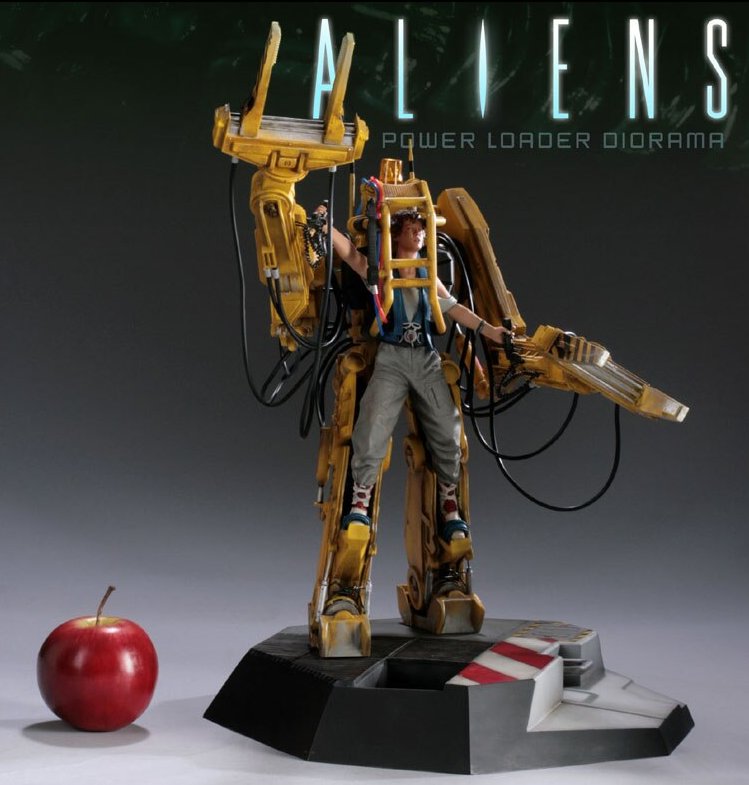
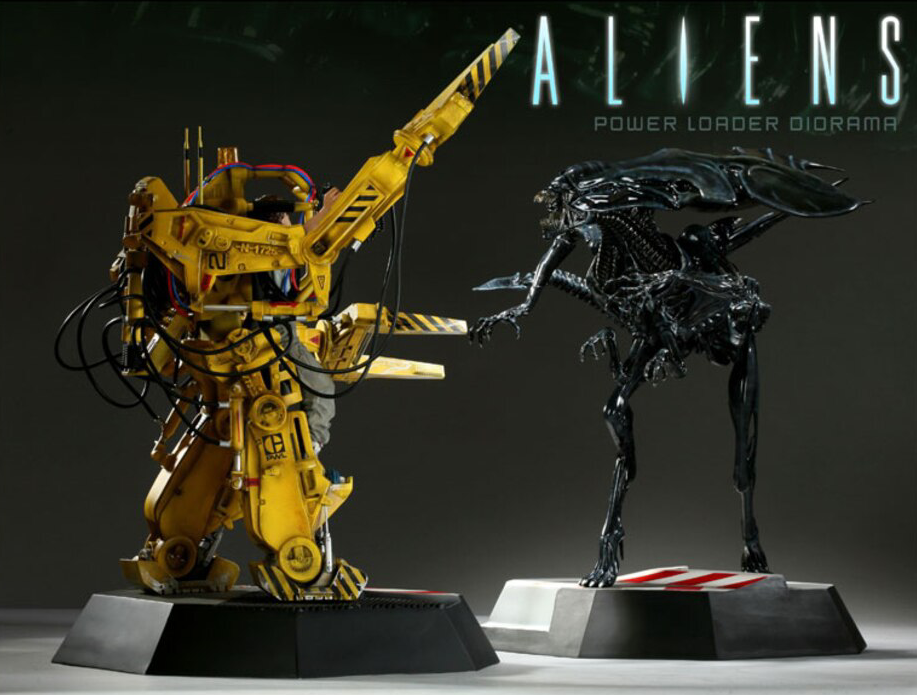
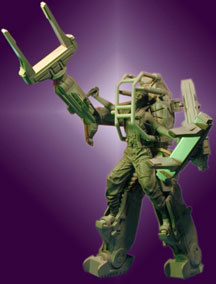

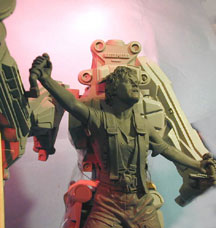
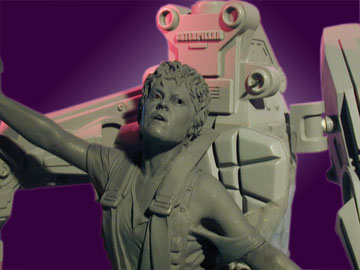
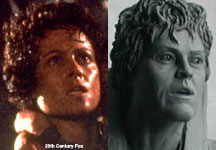
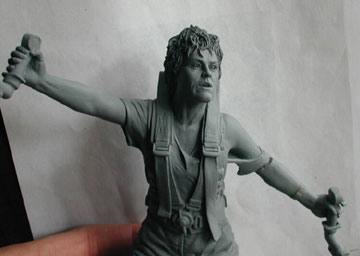
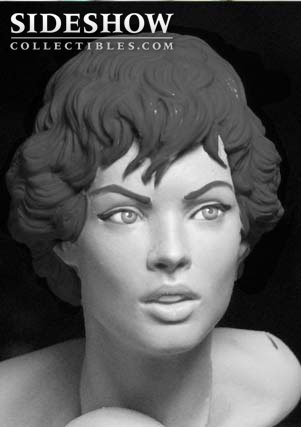

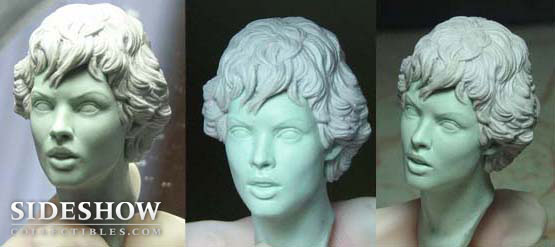
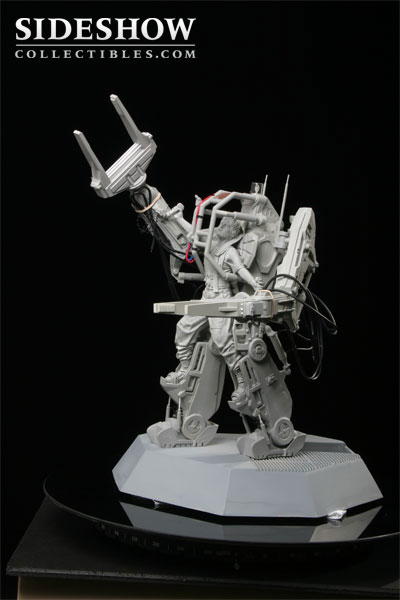
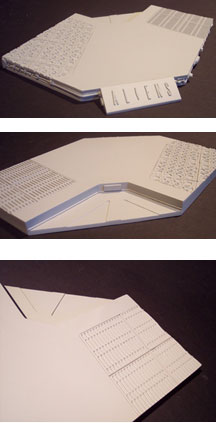
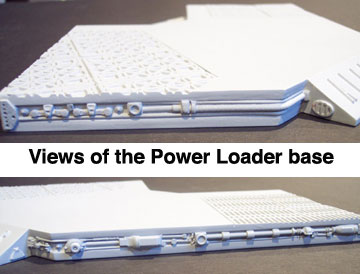
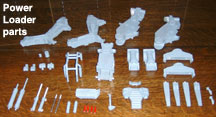
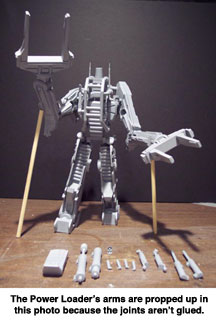
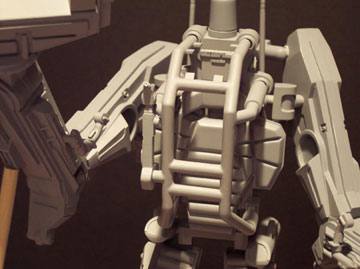
'기계 Mechanical > 미분류' 카테고리의 다른 글
| 엑소슈트 디스트릭트9 WETA - Exosuit District 9 (0) | 2022.09.28 |
|---|---|
| 외계인 조우 시드 미드 Alien Encounter (Syd Mead design) (0) | 2022.09.13 |
| BLIMP 블레이드러너 Blade Runner BLIMP Studio Size 1/2 (0) | 2022.08.25 |
| 자이언트 모아 기계식 New Zealand Giant Moa (0) | 2022.08.15 |
| 로보캅 2 케인 Chronicle Collectibles - Robocop Cain (0) | 2022.08.01 |



